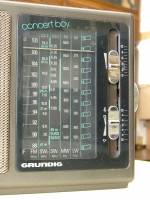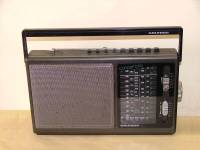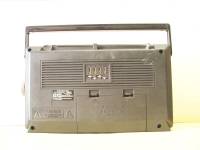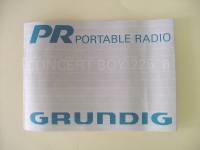 |
GRUNDIG Concert Boy 225a Malaysia 1988 |
 |
 Italiano
Italiano |
English
 |
||
 Grundig mod. Concert Boy 225a - Costruito in Malesia nel 1988.
Grundig mod. Concert Boy 225a - Costruito in Malesia nel 1988.Il Concert Boy 225a è un ricevitore supereterodina con copertura su cinque bande di frequenza: OL, OM, OC1, OC2 e FM. La copertura in frequenza è OL: 140 - 290 KHz - OM: 515 - 1630 KHz, OC1: 5,8 - 6,4 MHz, Oc2: 6,8 - 18,5 MHz, FM: 87,5 - 108 MHz. In Fm c'è la possibilita' di preselezionare quattro frequenze tramite quattro manopole poste sul retro. L'antenna per FM è a stilo, i potenziometri del volume e del tono sono del tipo a cursore mentre la manopola per la sintonia è sul lato destro. Nella parte superiore oltre al tasto di accensione ci sono i pulsanti per il cambio di gamma e i quattro tasti di preselezione per la FM. La scala parlante è analogica e la radio è dotata di maniglia per il trasporto. L'alimentazione è fornita da 4 batterie da 1.5 V tipo D (LR20 o UM1) oppure tramite la rete a 220 Vac. Le dimensioni sono: 31,5 x 18,5 x 7 cm (L,A,P), e il peso è di 1.5 kg. © IK3HIA, 2004. |
|||
|
|
|||
 |
 |
 |
|
 Grundig
mod. Concert Boy 225a - Made in Malaysia in 1988.
Grundig
mod. Concert Boy 225a - Made in Malaysia in 1988.The Concert Boy 225a is a superheterodyne receiver covering five frequency bands: OL, OM, OC1, OC2 and FM. Frequency coverage is OL: 140 - 290KHz - OM: 515 - 1630KHz, OC1: 5.8 - 6.4MHz, Oc2: 6.8 - 18.5MHz, FM: 87.5 - 108MHz. In FM there is the possibility of pre-selecting four frequencies using four knobs on the back. Whip antenna for FM, the volume and tone potentiometers are slider type while the tuning knob is on the right side. In the upper part, in addition to the power button, there are the buttons for changing the bands and the four preset buttons for FM. The dial scale is analog and the radio is equipped with a carrying handle. Power is supplied by 4 1.5 V type D batteries (LR20 or UM1) or via the 220 Vac mains. The dimensions are: (W,H,D) 12.4 x 7.3 x 2.8 inch, and the weight is 3 lb 4.9 oz. © IK3HIA, 2004. |
|||
 |
 |
 |
|
|
Back to the top of the page >>
|
|||
|
|
Return to: IK3HIA home page |
|
Return to: Transistor Radio |
|
Go to: Transistor diagrams |